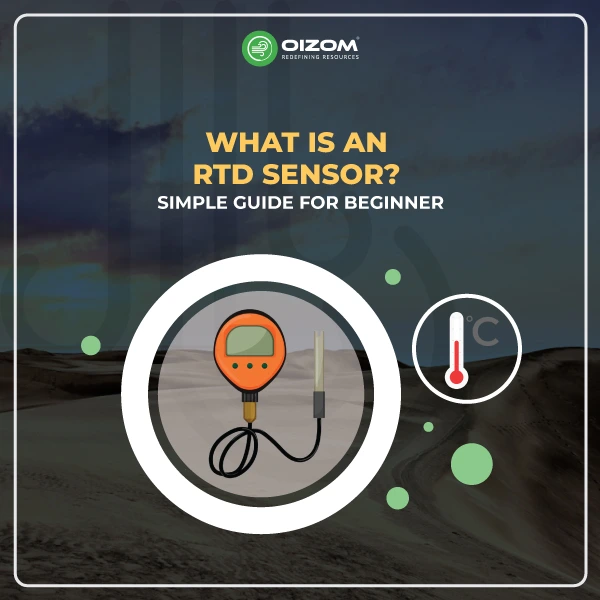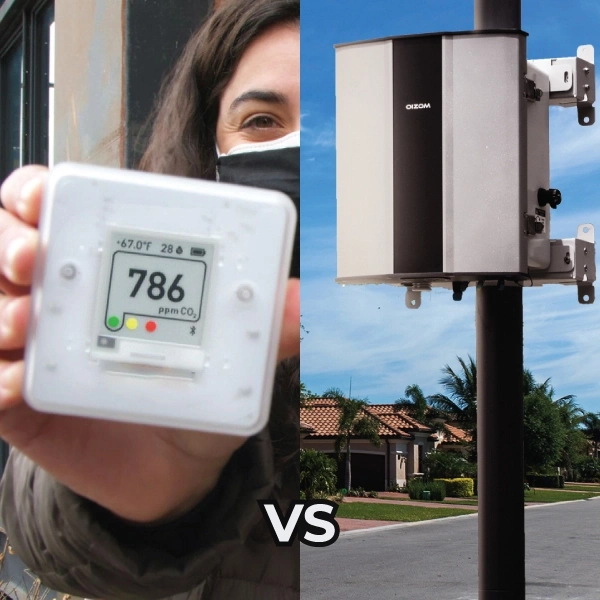10 Key Takeaway Points:
- What is an RTD? RTD sensors measure temperature by changing resistance with temperature changes, offering high precision and reliability.
- Types of RTDs: There are two main types: thin-film RTDs, which are cost-effective and vibration-resistant, and wire-wound RTDs, known for high accuracy.
- How RTDs Work: RTDs function by changing the resistance of metals like platinum in response to temperature changes, making them ideal for accurate temperature monitoring.
- Solid-State vs. RTD: Oizom Weathercom uses solid-state semiconductor sensing due to its compact design, durability, and quick response, unlike bulkier RTD sensors.
- Industries Using RTDs: RTD sensors are widely used in industries like pharmaceuticals, food processing, heavy machinery, solar power, and medical devices for precise temperature control.
- Components of an RTD: Key elements include the sensing element, protective tubing, and platinum wire, chosen for accuracy and stability over a wide temperature range.
- Benefits of RTD Sensors: RTDs offer high accuracy, repeatability, long-term stability, and consistent readings across varied applications.
- Drawbacks of RTDs: RTDs can be more expensive, less rugged in high-vibration environments, and have slower response times compared to some alternatives.
- Why Solid-State Sensing?: Solid-state sensors are chosen for their energy efficiency, compactness, and speed, making them a better fit for portable and low-power devices.
- Choosing the Right Sensor: Understanding the strengths and limitations of RTDs helps industries decide when to opt for them or choose alternatives like solid-state sensing for specific needs.
What is an RTD Sensor? Simple Guide for Beginner
RTD sensors, or Resistance Temperature Detectors, are known for their precise temperature measurements. They work by changing their electrical resistance as temperatures change, which makes them incredibly accurate and dependable. You’ll often find them in places where reliable temperature readings matter most like industrial processes, HVAC systems, and research labs. What sets RTDs apart is their blend of accuracy, stability, and long-lasting performance. Wondering how they work and why so many industries rely on them? In this blog, we’ll break down everything you need to know about RTD sensors and what makes them such a trusted choice.
RTD sensors types
There are two types of RTDs. The temperature-sensing element’s design determines their type. The first type has wire-wound parts, and the second type contains thin-film components.
Thin Film RTD:
- Thin-film RTD elements are manufactured by depositing a thin layer of metal, typically platinum, on a ceramic substrate. The metal film is laser cut or embossed to create an electrical circuit layout with the desired resistance. The lead wires are attached, and the entire element is coated with a thin protective glass layer.
- Thin-film RTDs have the advantage of being both dependable and inexpensive to manufacture. Furthermore, they withstand vibrations better than other forms of resistance temperature detectors.
Wire wound RTDs:
- The other type of RTD is wire-wound. Its sensing element is a tiny coil of ultra-thin platinum wire. The wire coil is often packaged within a ceramic or glass tube, or it can be looped around the outside of a ceramic or glass housing material.
- Wire-wound RTDs have the benefit of being very accurate, and those with glass cores may be immersed in a wide range of liquids. In contrast, those with ceramic cores can accurately monitor extremely high temperatures.
- The downsides of wire-wound RTDs are higher production costs and increased vibration sensitivity.
How does an RTD Sensor Work?
Let’s dive into how an RTD operates! At its core, the working principle of an RTD is straightforward yet effective. Here’s a closer look at how it functions.
- The functioning principle of an RTD sensor is simple. As the temperature of the metal rises, its resistivity varies. The change in resistance can be monitored and used to calculate the temperature.
- RTD sensors are essential in manufacturing and sensitive temperature processes because of their excellent accuracy and tolerance to temperature variations, vibrations, and shocks. They use a limited DC to prevent overheating and provide consistent operation.
- It is advised that the sensor be installed in an application with a thermowell, which is a closed end tube mounted on the process stream. The procedure transmits heat to the thermowell wall and then to the sensor. A thermowell is a thermally conductive protrusion that is inserted in a process line to allow sensing equipment to be installed without opening a hole in the line.
- Most RTD sensors are enclosed in a protective sheath made of stainless steel or Inconel, which protects the detecting element from environmental and mechanical harm. This design allows the sensor’s measuring end to be put directly into the measurement region, with termination wires connecting it to the recording device.
What are the uses of RTD sensors?
Sensors are essential in production because they measure physical events using metal and fluid properties. Among these, the resistance temperature detector (RTD) is a precise, durable, and dependable device that gives useful information for application monitoring.
The usage of RTD sensors has increased because of their predictable linear resistance change with temperature, which assures constant and precise temperature measurements.
- Solar Power RTD Sensors: In solar power systems, homogeneous heat dispersion is critical for effective electricity generation. RTD sensors, which do not overheat, are ideal for monitoring temperatures in solar panels. They also serve a similar purpose in grid-connected wind turbines by tracking temperature swings.
- Pharmaceutical RTD Sensors: Precise temperature control is critical in drug manufacturing to avoid formulation degradation. RTD sensors are essential in research, formulation, testing, and production processes because they ensure precise temperature regulation in a highly controlled environment.
- Food Processing: Temperature monitoring is required at all stages of food production, including manufacture, storage, and shipping. RTD sensors are used to maintain accurate temperature control during various procedures.
- Heavy Industry: Temperature monitoring is essential to prevent damage and maintain the safe operation of machinery, electric motors, windings, generators, ovens, and microwave power systems.
- Medical: In the medical industry, accurate temperature control is critical for patient care, as shown in infant incubators, respiratory equipment, and dialysis machines.
Compounds of RTD sensors
Resistance temperature detectors (RTDs) have six main components: the sensor device, wire, protective tubing, connection fitting, outside diameter, and termination. The arrangement and specifications of these components determine the many types of RTD sensors, which influence their accuracy and performance. Despite differences in capability, RTD sensors’ core components are similar.
Typically, an RTD has a sensing element consisting of platinum, nickel or copper. These metals were chosen for their precise and positive temperature coefficients. Platinum is the most popular because of its exceptional corrosion resistance and long-term stability.
- Resistance Elements
- Wires
- Tubing Material
- Connection Fitting
- Outer Diameter
- Termination
What are the benefits of RTD?
Since its introduction during the first industrial revolution, RTD sensors have become an essential component of production operations. Their remarkable accuracy and stability make them perfect for temperature monitoring, as they provide instant data with little effort.
In industrial processes, precise temperature monitoring is critical to ensuring that equipment functions properly. Because of their precision and accuracy, RTD sensors are a reliable method of achieving and maintaining ideal temperatures.
- Cost: RTD sensors typically cost more than alternative temperature measurement technologies. However, the investment is justified by its accuracy, lifespan, repeatability, and stability, which result in overall cost reductions.
- Sensitivity: One of the most important needs for a sensor is the ability to relay data quickly. RTD sensors provide quick and exact temperature readings. Thin film Pt100 sensors have seen considerable improvements in response times.
- Accuracy: RTD sensors are preferred for accuracy, with typical variations of 0.1°C. This high level of precision is due to their linearity, which guarantees consistent performance.
- Linearity: Linearity describes a sensor’s capacity to respond proportionally to temperature changes over its whole range. A sensor with high linearity produces a resistance change that correctly reflects temperature change, adding to the RTD sensor’s well-known precision and reliability.
- Elements: RTD sensors are made of high-quality pure metals, ensuring accurate readings.
Advantages and Disadvantages of RTD Sensors
RTD (Resistance Temperature Detector) sensors offer precise temperature measurements, making them ideal for applications needing accuracy and stability. They’re known for their high repeatability and reliability, which ensures consistent readings over time. RTDs are also highly sensitive, providing accurate readings across a wide temperature range, making them perfect for industrial processes, laboratories, and environmental monitoring. Their stable and linear output simplifies calibration, further adding to their appeal.
Below are the advantages of RTD Sensors
- Highly accurate
- High repeatability
- Consistent
- Offer precise measurement even in extreme environments
- Long term stability
- Platinum RTD is suitable for higher temperature ranges
- Most accurate and stable over time (when compared to thermocouples and thermistors)
However, RTD sensors come with a few drawbacks. They can be more expensive than other temperature sensors, such as thermocouples. This cost is due to their design and the use of materials like platinum, which ensures precision. Additionally, RTDs are less robust in extremely high temperatures, making them unsuitable for specific applications where thermocouples perform better. Their response time is also slower than other sensors, which might not be ideal for applications requiring rapid measurements.
Below are the disadvantages of RTD Sensors
- Smaller overall temperature range
- Higher Initial cost
- Less rugged in high-vibration environments
- They require more complex measurement circuit
- Self-heating and lead errors when high accuracy is needed,
Overall, RTD sensors are a great choice when accuracy and stability are key, but they may not be the best fit for every situation. Weighing their pros and cons helps determine if they meet the specific needs of your application.

On the other hand, RTD sensors, although accurate over a wide temperature range, come with certain drawbacks. They are bulkier, more expensive, and require external power sources, making them less suitable for compact and portable applications. Additionally, RTDs are slower to respond to rapid temperature changes. This is why we chose solid-state semiconductor sensing for Weathercom. It strikes the right balance between accuracy, speed, and efficiency.
Conclusion
In conclusion, an RTD, or resistance temperature detector, is a passive temperature sensing device that operates on the principle that the resistance of a metal changes as the temperature changes. RTD sensors are a reliable choice for temperature measurement across various industries. With their precision, stability, and wide range of applications, they play a crucial role in processes that demand consistent temperature monitoring. While they might come with a higher price tag and slower response times, their benefits often outweigh these limitations for many use cases. Understanding how RTD sensors work helps you make an informed decision about whether they are the right fit for your needs or not, ensuring you get the best performance in your temperature-sensing applications.






